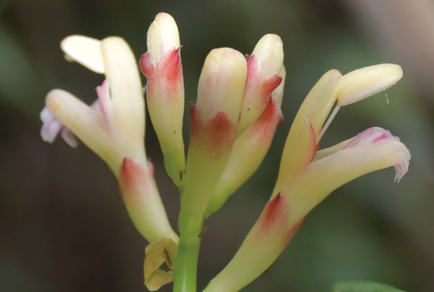Abstract
The identities and nomenclature histories of two endemic gingers from China, viz. Alpinia brevis and A. bambusifolia, are reviewed. Alpinia brevis was previously thought to be a widespread species, distributed in Hainan, Guangxi and Yunnan, while A. bambusifolia was known to be endemic to Guangxi. Nevertheless, the results in this study suggest that the collections from Guangxi and Yunnan were misidentified as A. brevis, those of which from Guangxi should belong to A. jianganfeng or Globba aff. racemosa, while those from Yunnan should belong to A. bambusifolia. The treatment that A. nanchuanensis is a synonym of A. bambusifolia is supported by our studies. After this revision, A. brevis is restricted to Hainan, while A. bambusifolia occurs in Chongqing, Guangxi, Guizhou and Yunnan, China. Lectotype is designated for A. nanchuanensis here.
References
- Bachman, S., Moat, J., Hill, A.W., de la Torre, J. & Scott, B. (2011) Supporting Red List threat assessments with GeoCAT: geospatial conservation assessment tool. ZooKeys 150: 117–126. https://doi.org/10.3897/zookeys.150.2109
- De Boer, H., Newman, M., Poulsen, A.D., Droop, J., Fér, T., Hiền, L.T.T., Hlavatá, K., Lamxay, V., Richardson, J.E., Steffen, K. & Leong-Škorničková, J. (2018) Convergent morphology in Alpinieae (Zingiberaceae): recircumscribing Amomum as a monophyletic genus. Taxon 67: 6–36. https://doi.org/10.12705/671.2
- Docot, R.V.A., Banag, C.I. & Poulsen, A.D. (2019a) Reinstatement and revision of the genus Adelmeria (Zingiberaceae) endemic to the Philippines. Taxon 68: 499–521. https://doi.org/10.1002/tax.12071
- Docot, R.V.A., Banag, C.I., Tandang, D.N., Funakoshi, H. & Poulsen, A.D. (2019b) Recircumscription and revision of the genus Vanoverberghia (Zingiberaceae). Blumea 64: 140–157. https://doi.org/10.3767/blumea.2019.64.02.05
- Fang, D. (1978) Some new taxa of Zingiberaceae from Kwangsi. Acta Phytotaxonomica Sinica 16 (4): 77–81.
- Fang, D. (2016) Zingiberaceae. In: Guangxi Institute of Botany, Guangxi Zhuang Autonomous Region and Chinese Academy of Sciences (Org.) Flora of Guangxi, Vol. 5, Guangxi Science & Technology Publishing House, Nanning, pp. 75–111.
- IUCN (2022) Guidelines for Using the IUCN Red List Categories and Criteria, version 15.1. IUCN Red List Unit, Cambridge U.K. [https://www.iucnredlist.org/documents/RedListGuidelines.pdf]
- Kress, W.J., Prince, L.M. & Williams, K.J. (2002) The phylogeny and a new classification of the gingers (Zingiberaceae), evidence from molecular data. American Journal Botany 89: 1682–1696. https://doi.org/10.3732/ajb.89.10.1682
- Kress, W.J., Liu, A.Z., Newman, M. & Li, Q.J. (2005) The molecular phylogeny of Alpinia (Zingiberaceae): a complex and polyphyletic genus of gingers. American Journal Botany 92: 167–178. https://doi.org/10.3732/ajb.92.1.167
- Kress, W.J., Newman, M.F., Poulsen, A.D. & Specht, C. (2007) An analysis of generic circumscriptions in tribe Alpinieae (Alpinioideae: Zingiberaceae). Gardens’ Bulletin Singapore 59: 113–128.
- Larsen, K., Lock, J.M., Maas, H. & Maas, P.J.M. (1998) Zingiberaceae. In: Kubitzki, K. (Ed.) The families and genera of vascular plants, Vol. IV, Springer-Verlag, Berlin, pp. 474–495. https://doi.org/10.1007/978-3-662-03531-3_49
- Leong-Škorničová, J. & Newman M.F. (2015) Gingers of Cambodia, Laos and Vietnam. Singapore Botanic Gardens, National Parks Board, in association with Royal Botanic Garden Edinburgh and Pha Tad Ke Botanical Garden, Singapore, 229 pp.
- McNeill, J. (2014) Holotype specimens and type citations: general issues. Taxon 63: 1112–1113. https://doi.org/10.12705/635.7
- Roxburgh, W. (1810) Descriptions of several of the monandrous plants of India, belonging to the natural order called Scitamineae by Linnaeus, Cannae by Jussieu, and Drimyrhizae by Ventenat. Asiatic Researches 11: 318–362.
- Schumann, K. (1904) Zingiberaceae. In: Engler, H.G.A. (Ed.) Das Pflanzenreich, Vol. IV-46, Verlag von Wilhem Engelmann, Leipzig, pp. 1–458.
- Smith, J.E. (1808) Exotic Botany: Consisting of Coloured Figures, and Scientific Descriptions of such New, Beautiful, or Rare Plants as are Worthy of Cultivation in the Gardens of Britain; with Remarks on Their Qualities, History, and Requisite Modes of Treatment, Vol. 2, R. Taylor & Co, London, pp. 1–122.
- Smith, R.M. (1990) Alpinia (Zingiberaceae): a proposed new infrageneric classification. Edinburgh Journal of Botany 47: 1–75. https://doi.org/10.1017/S0960428600003140
- Thiers, B. (continuously update) Index Herbariorum: a global directory of public herbaria and associated staff. New York Botanical Garden’ s Virtual Herbarium. Available from: https://sweetgum.nybg.org/ih/ (accessed 11 August 2023)
- Turland, N.J., Wiersema, J.H., Barrie, F.R., Greuter, W., Hawksworth, D.L., Herendeen, P.S., Knapp, S., Kusber, W.H., Li, D.Z., Marhold, K., May, T.W., McNeill, J., Monro, A.M., Prado, J., Price, M.J. & Smith, G.F. (2018) International Code of Nomenclature for algae, fungi, and plants (Shenzhen Code) adopted by the Nineteenth International Botanical Congress Shenzhen, China, July 2017. Regnum Vegetabile 159. Koeltz Botanical Books, Glashütten, 254 pp. https://doi.org/10.12705/Code.2018
- Tong, S.Q. (1997) Zingiberaceae. In: Wu, Z.Y. (Ed.) Flora Yunnanica, Vol. 8, Science Press, Beijing, pp. 528–651.
- Wu, C.Y. (1984) Index Florae Yunnanensis, Vol. 2, The People’s Publishing House, Kunming, 1188 pp.
- Wu T.L. & Chen, S.J. (1991) Zingiberiaceae. In: Wu, T.L. (Ed.) Flora of Guangdong, Vol. 2, Guangdong Science and Technology Press, Guangzhou, pp. 401–432.
- Wu, T.L. & Chen, S.J. (1978) Materials for Chinese Zingiberaceae. Acta Phytotaxonomica Sinica 16: 25–48.
- Wu, T.L. & Chen, S.J. (1981) Alpinia. In: Wu, T.L. (Ed.) Flora Reipublicae Popularis Sinicae, Vol. 16. Science Press, Beijing, pp. 110–135.
- Wu, T.L. (1998) Notes on the Lowiaceae, Musaceae, and Zingiberaceae for the Flora of China. Novon 7 (4): 440–442. https://doi.org/10.2307/3391779
- Wu, T.L. & Larsen, K. (2000) Zingiberiaceae. In: Wu, Z.Y. & Raven, P.H. (Eds.) Flora of China, Vol. 24, Science Press, Beijing & Missouri Botanical Garden Press, St. Louis, pp. 322–377.
- Ye, X.E., Nguyen, K.S., Souvannakhoummane, K., Nguyen, Q.B. & Chen, J. (2021) Alpinia laosensis, the correct name for a species previously misidentified as A. conchigera. Phytotaxa 508 (2): 129–141. https://doi.org/10.11646/phytotaxa.508.2.2
- Zhao, Z.L., Zhong, G.Y. & Xu, L.S. (2002) The identity of Alpinia nanchuanensis Z.Y. Zhu. Journal of Systematics and Evolution 40 (2): 187–189.
- Zhu, Z.Y. (1986) Two new species of Alpinia from Sichuan. Journal of Sichuan of Traditional Chinese Medicine 1986 (3): 15–18.
- Zhu, Z.Y. (1987) A new species of Alpinia from Sichuan. Guihaia 7 (4): 295–296.
- Zhu, Z.Y. (1992) Zingiberaceae. In: Sichuan Flora Editorial Committee (Org.) Flora Sichuanica, Vol. 10, Sichuan Ethnic Press, Chengdu, pp. 587–631.


